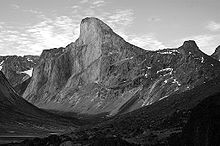- Mount Thor
-
Mount Thor 
Mount Thor in 1997Elevation 1,675 m (5,495 ft) [1] Location Location Nunavut, Canada Range Baffin Mountains Coordinates 66°32′N 065°19′W / 66.533°N 65.317°WCoordinates: 66°32′N 065°19′W / 66.533°N 65.317°W[1] Topo map NTS 026.I.11 Mount Thor, officially gazetted as Thor Peak, is a mountain with an elevation of 1,675 m (5,495 ft) located in Auyuittuq National Park, on Baffin Island, Nunavut, Canada. The mountain is located 46 km (29 mi) northeast of Pangnirtung and features the Earth's greatest purely vertical drop at 1,250 m (4,101 ft), with an average angle of 105 degrees. This feature makes the site popular with climbers, despite its remoteness. Camping is allowed, with the only official site being at the entrance to the Akshayuk Valley near Overlord Peak.
Mount Thor is part of the Baffin Mountains which in turn form part of the Arctic Cordillera mountain range. The mountain is made of granite and is the most famous of Canada's mountains named "Thor".[1]
Mount Thor was first climbed in 1953 by an Arctic Institute of North America team. The team members were Hans Weber, J Rothlisberger and F. Schwarzenbach. The same men climbed the North Tower of Mount Asgard for the first time.
The world record for longest rappel was set on Mount Thor, July 23, 2006, by an American team consisting of: Chuck Constable, Dirk Siron, Ben Holley, Kenneth Waite, Gordon Rosser, Donny Opperman, Deldon Barfuss, and Tim Hudson. A 26-year-old Canadian national park warden, Philip Robinson, also rappelled, but had a problem with his equipment and was killed when he dropped to the base of the mountain. There had been a previous attempt in 2004, but they returned without rappelling due to dangerous weather conditions.[2]
Contents
Notable ascents
- 1985 Direct West Face FA by Earl Redfern, John Bagley, Eric Brand, Tom Bepler.[3]
See also
- Trango Towers, the tallest near-vertical drop on earth.
References
- ^ a b c "Thor Peak". Bivouac.com. http://www.bivouac.com/MtnPg.asp?MtnId=4155. Retrieved 2009-11-30.
- ^ "Friends, family mourn death of parks officer". Nunatsiaq News. August 11, 2006. Archived from the original on June 12, 2008. http://web.archive.org/web/20080612032817/http://www.nunatsiaq.com/archives/60811/news/nunavut/60811_10.html.
- ^ Redfern, Earl (December 1995), "-Mount Thor - 33 Days on the West Face", Climbing Magazine (93): 34–36, ISSN 0045-7159
External links
- A Dallas Morning News article about Mt. Thor and other Akshayuk Pass features by writer Dave Levinthal
Mountains of Nunavut Kitikmeot Region Kivalliq Region Qikiqtaaluk Region Apex · Polar Sun Spire
Mountains of the
Arctic CordilleraAdam · Angilaaq · Angna · Arthur · Asgard · Baffin · Baldr · Bastille · Battle · Beaufort · Biederbick · Blackwelder · Blue · Boulder · Breidablik · Bruce · Byam Martin · Challenger · Commonwealth · Conger · Cunningham · Douro · Everett · Garfield · Geodetic · Grinnell · Grogan Morgan · Haddington · Hartz · Inglefield · Innuitian · Jeffries · Joy · Kisimngiuqtuq · Krag · Krieger · Midnight Sun · Nukap · Odin · Osborn · Outlook · Precipitous · Prince of Wales · Princess Margaret · Qiajivik · Sawtooth · Scoresby · Selamiut · Stokes · Stokes · Swiss · Thor · Thorndike · Thule · Torngat · Treuter · Ukpik · Victoria and Albert · White Crown · White TripletsMountains of the
British Empire RangeMountains of the
United States RangeCategories:- Arctic Cordillera
- Extreme points of Earth
- Baffin Island
- Cliffs of Canada
- Qikiqtaaluk Region, Nunavut geography stubs
Wikimedia Foundation. 2010.

